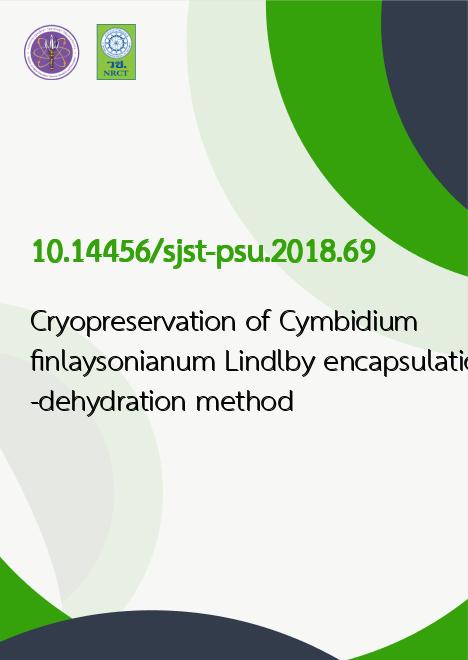
|
Cryopreservation of Cymbidium finlaysonianum Lindl.by encapsulation-dehydration method |
|---|---|
| รหัสดีโอไอ | |
| Creator | 1. Wiphusinee Worrachottiyanon 2. Sumontip Bunnag |
| Title | Cryopreservation of Cymbidium finlaysonianum Lindl.by encapsulation-dehydration method |
| Publisher | Research and Development Office, Prince of Songkla University |
| Publication Year | 2561 |
| Journal Title | Songklanakarin Journal of Science and Technology |
| Journal Vol. | 40 |
| Journal No. | 3 |
| Page no. | 682 |
| Keyword | encapsulation-dehydration technique, protocorms, RAPD analysis, cryopreservation |
| URL Website | http://rdo.psu.ac.th/sjstweb/index.php |
| ISSN | 0125-3395 |
| Abstract | Thailand is home to a variety of wild orchids, most of which grow on trees in the forests. However, overexploitation ofwild populations along with loss of habitat has accounted for the threatened status of wild orchids. Hence, conservation of wildorchids is urgently needed in the country. The specific purpose of this study was to establish a simple and reproducible protocolfor the encapsulation-dehydration based cryopreservation of the orchid species Cymbidium finlaysonianum, which represents oneof the threatened orchid species in Thailand. In this study, protocorms (2-3 mm in diameter) of the orchid were precultured for 24h in liquid New Dogashima (ND) medium containing 0-1 M sucrose, encapsulated in 3% w/v Ca-alginate, pretreated for 24 h inliquid ND medium supplemented with 1.5 M sucrose and dehydrated for 0-12 h before plunging into liquid nitrogen for 48 h. Theresults showed that preculture of the protocorms with 0.75 M sucrose before encapsulation, followed by pretreatment with 1.5 Msucrose and dehydration for 12 h yielded the highest viability and regrowth (65.56%) of the protocorms determined following a48 h cryopreservation process. Random amplified polymorphic DNA analysis employed for comparison of the polymorphicbands between plantlets raised from non-cryopreserved and cryopreserved protocorms revealed a similar index value of 0.998indicating the genetic stability of the cryopreserved protocorms. |
